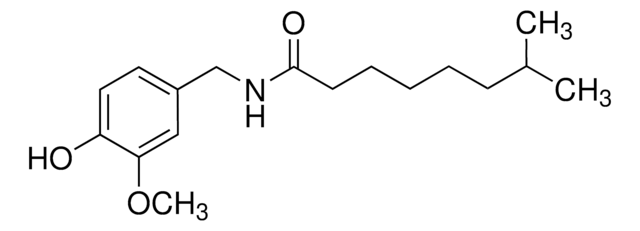M2028
Capsaicin
from Capsicum sp., ≥95% (HPLC), powder, TRPV1 agonist
Sinónimos:
8-Methyl-N-vanillyl-trans-6-nonenamide
About This Item
Productos recomendados
product name
Capsaicin, ≥95%, from Capsicum sp.
biological source
Capsicum sp.
assay
≥95%
mp
62-65 °C (lit.)
solubility
H2O: insoluble
ethanol: soluble
storage temp.
2-8°C
SMILES string
COc1cc(CNC(=O)CCCC\C=C\C(C)C)ccc1O
InChI
1S/C18H27NO3/c1-14(2)8-6-4-5-7-9-18(21)19-13-15-10-11-16(20)17(12-15)22-3/h6,8,10-12,14,20H,4-5,7,9,13H2,1-3H3,(H,19,21)/b8-6+
InChI key
YKPUWZUDDOIDPM-SOFGYWHQSA-N
Gene Information
human ... CYP1A2(1544) , TRPV1(7442)
rat ... Trpv1(83810) , Trpv4(66026)
¿Está buscando productos similares? Visita Guía de comparación de productos
General description
Application
- to study its effects on chromatin remodeling and gene expression related to synaptic plasticity
- to study TRPV1 channel signaling in H2C1 cells (which are human embryonic kidney 293 cells expressing TRPV1 channels)
Biochem/physiol Actions
signalword
Danger
Hazard Classifications
Acute Tox. 2 Oral - Eye Dam. 1 - Resp. Sens. 1 - Skin Irrit. 2 - Skin Sens. 1 - STOT SE 3
target_organs
Respiratory system
Storage Class
6.1A - Combustible acute toxic Cat. 1 and 2 / very toxic hazardous materials
wgk_germany
WGK 3
flash_point_f
235.4 °F - closed cup
flash_point_c
113 °C - closed cup
ppe
Eyeshields, Faceshields, Gloves, type P2 (EN 143) respirator cartridges
Certificados de análisis (COA)
Busque Certificados de análisis (COA) introduciendo el número de lote del producto. Los números de lote se encuentran en la etiqueta del producto después de las palabras «Lot» o «Batch»
¿Ya tiene este producto?
Encuentre la documentación para los productos que ha comprado recientemente en la Biblioteca de documentos.
Los clientes también vieron
Nuestro equipo de científicos tiene experiencia en todas las áreas de investigación: Ciencias de la vida, Ciencia de los materiales, Síntesis química, Cromatografía, Analítica y muchas otras.
Póngase en contacto con el Servicio técnico










